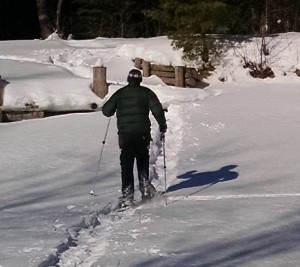Be careful on that ice!
It’s been a wicked cold winter. An article in the Adirondack Daily Enterprise last week put the thickness of ice on one North Country lake near Saranac Lake at a whopping thirty inches. That sounds bomb-proof. But it’s still important to use caution when playing in the back country.
On Saturday, while snow-shoeing on a stretch of the Racquette River near Tupper Lake, I plunged through a rotten section of ice and got soaked to the waist. Crawling out, thankfully, was no sweat.
It could have been a lot worse. Just last month, two North Country men died in northern Franklin County after their snowmobiles went through the ice.
But even my little misadventure made for chilly trek back to the trailhead. (It’s no fun to be out and about when it’s 11 degrees F and your backside is dripping…) And it was a sharp reminder that even after a true Adirondack February, skiers, snowshoers, ice fishermen, and sledders should use all the caution in the world when traveling on lakes and rivers.
I got overly confident and casual and got spanked. Here’s a primer from the Canadian Red Cross on ice safety.









Obviously true.
Brian, neither you nor the Red Cross site mentions the importance of carrying ice picks for self rescue. You can buy them on-line or make your own. Basically they are two spikes connected by a cord and used to help you claw your way back onto the ice after you fall through. A more awkward tool is a long pole carried across your body and long enough to bridge any hole you might break through. It worked for my brother Mark and me years ago when we both fell through thin ice. I fell through first, and while he was laughing at me he fell through. Wet to our chests and the color of lobsters after taking off our wet clothes.
The brook ice in the backcountry is some of the worst in several seasons. We had some greatly fluctuating water levels in early winter then consistently cold ever since with ever dropping water levels. That has meant a very weak top layer with lots of air and multiple layers underneath. I have broken through many times this winter.
John – That’s great advice. During my misadventure I was carrying ski poles and fortunately in my case they worked great. I was able to use the baskets of the polls as spikes to get purchase and pull myself up. But the equipment you describe is far preferable. -Brian, NCPR
Brian, As a local you should know better than to be snowshoeing on the Raquette River, it flows strong even in the winter and may look safe but can be very thin in areas where the current is swift.
You know how they advise homeowners who fear frozen pipes to leave the water running? Rivers are always running! And once they freeze over, there’s no way to know where the current is flowing near the surface. Stick to lakes and ponds, and stay away from inlets, outlets and bubblers.